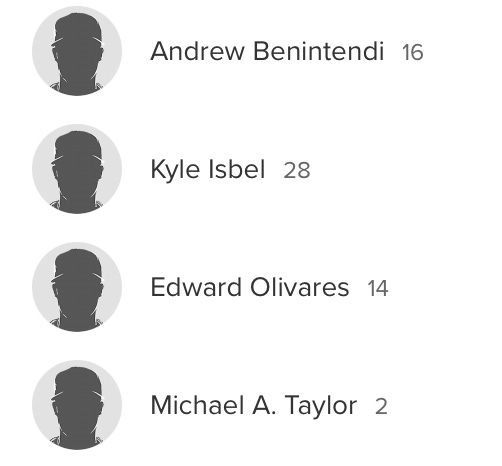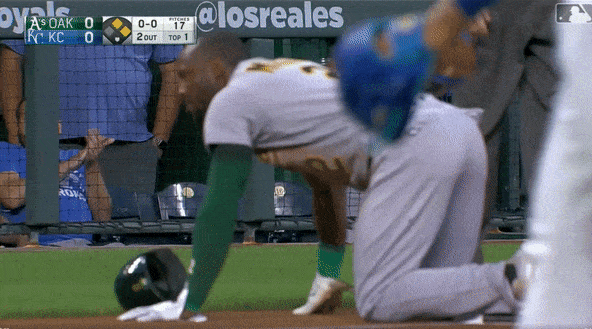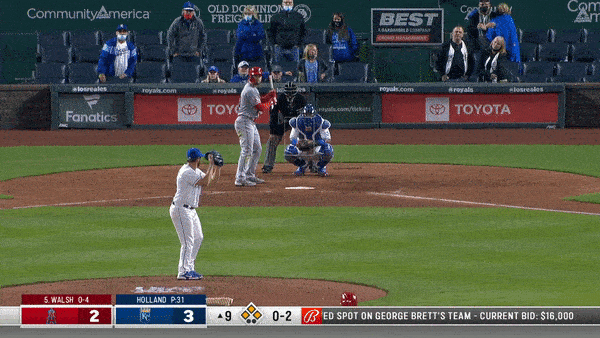My ballot for the Royals team awards
It's a month late, but I reveal my ballot for the Royals Player and Pitcher of the Year. Along with an award for Special Achievement.
December was insane.
It’s not necessary to go into the gory details here (they wouldn’t interest you anyway), but when I logged in to my dashboard to jot down some notes over the holidays, I discovered it had been about a month since a dispatch had been sent of any kind. I’m horrified.
I mean, what’s my problem? The owners didn’t lock me out.
Thanks for hanging with me. Hope you’re having a happy new year. Forgive me for taking a bit to catch up on some news I had intended to touch on in the last month.
The Royals announced their team awards at the end of November, getting it in before the owners locked out the players. Normally, the club makes this announcement in late January, ahead of FanFest, which is odd timing if you ask me—naming your award-winners from the previous season when you’re trying to drum up excitement for the upcoming season has a high chance to backfire in a spectacular fashion. Since the team websites have basically scrubbed all reference to the players on the 40-man roster, now we understand what the rush was all about.
The awards went like this:
Les Milgram Player of the Year - Salvador Perez
Bruce Rice Pitcher of the Year - Scott Barlow
Joe Burke Special Achievement Award - Nicky Lopez
It was the third time I’ve had the privilege of being among the media scrum voting for these honors. I’ll give a little peek into my thought process.
Royals Player of the Year
Salvador Perez picked up from where he left off in 2020 and absolutely blistered the baseball last summer, tying the franchise record with 48 home runs while driving in a team-high 121 runs. He led the club with a .544 slugging percentage, over 80 points higher than second-best Andrew Benintendi. Likewise, he set the pace with a 126 OPS+ and 127 wRC+…second place wasn’t particularly close.
It seemed like an automatic selection to list Salvy as the Royals’ most valuable player. But for me, it wasn’t that cut and dried.
Regular readers will know I’ve been consistently writing hosannas for Nicky Lopez and his complete transformation from playing himself out of a job last March to pacing the team with a .365 OBP, all the while playing outstanding defense at shortstop. If one was to look at the top performers from WAR as a jumping-off point for casting a ballot, it would lead to some thinking. And some confusion.
Here’s FanGraphs:
1) Nicky Lopez - 4.4 fWAR
2) Salvador Perez - 3.4 fWAR
3) Whit Merrifield - 3.2 fWAR
And Baseball-Reference:
1) Salvador Perez - 5.3 bWAR
2) Nicky Lopez - 4.3 bWAR
3) Whit Merrifield - 3.6 bWAR
I have Merrifield listed there just for a third-place context. He wasn’t seriously in the running for the Royals’ Player of the Year. (He’s probably going to use this as a slight against him and will serve as motivational fuel ahead of 2022.)
It’s an interesting comparison because both players achieved offensive success via different means. For Perez, it meant smashing the ball at a clip rarely seen in Kansas City. He did so without essentially altering his approach. He was chasing just as much as always, but he was making less contact on pitches out of the zone. The result was a higher strikeout rate (over a quarter of his plate appearances ended with him seeing—or offering at—strike three) but he was doing serious damage to the pitches he was connecting on. Even—as we learned yesterday at the start of the Salvy Home Run Countdown—the ones out of the zone.
For Lopez, it meant getting back to the type of hitter that propelled his success through his collegiate and minor league career. He moved away from an aggressive pull-happy approach he developed upon reaching the majors and instead waited for his pitch. He became a hitter who sprayed the ball to all fields while cutting down on his strikeout rate by almost eight percent. The result was an 80 point increase in OBP from 2020.
Lopez (and Merrifield) set the table. Perez cleared it off with gusto. Both players were hugely important contributors to an offense that could struggle to score runs. Remove either bat from the Royals’ lineup and the 4.23 runs per game the team scored could plummet into the sub-4 range.
The difference for the two players (at least when it came to FanGraphs) was on the defensive side of the ball. Perez topped 1,000 innings behind the plate for the first time since 2017 and was once again hugely successful in stopping (or at least discouraging) the running game, nabbing 44 percent of would-be base stealers. That was the best rate in baseball among backstops with at least 400 innings behind the plate.
But when it comes to framing…as you probably know, Perez grades very poorly. As in, the worst in baseball. According to Baseball Prospectus, Perez was worth a -12.2 framing runs. Only one other catcher was double-digits framing bad (Zack Collins of the White Sox at -10.1). Both were miles worse than Pedro Severino of Baltimore who checked in at a -7.5 framing runs. It’s a defensive metric, so you may want to take that with a grain of salt. I get that. But when a player is such an outlier in a particular metric, either good or bad, questions need to be asked. In Perez’s case, we can see with our own eyes that he’s not a good pitch framer. He has difficulty stealing strikes. But that’s not all pitch framing is. It goes the other way as well. Perez, it turns out, is costing his pitchers strikes with how he’s receiving the baseball. On a team with a young pitching staff, that’s an issue.
So while Perez was fantastic at cutting down larceny on the base paths, and while he was absolutely battered by the enormous number of pitches the Royals staff failed to throw over 60 feet…There’s still quite a deficiency in his defensive game. One that held him back in fWAR at least and probably cost him some voting position for the AL MVP award.
Still, Perez could be electric behind home plate. I’m sure you remember this…
Meanwhile, Lopez was a revelation in the field. He ranged to his right and up the middle to his left. He formed a stellar double-play combination with Merrifield. His quick hands and footwork around the bag was something to behold. He wasn’t the best shortstop in the AL, but he was certainly in the conversation. (I have no issue with Lopez not winning in an AL Gold Glove at short, but I will find the time to have an argument that he should’ve been a finalist. Of course, no one remembers the finalists…) Yet in a way, Lopez’s fine defense wasn’t so cut and dried. At least one metric found him to be rather mediocre.
The Fielding Bible (one of my preferred defensive metrics for the simplicity of presentation), rated Lopez as only +3 at shortstop. That ranked him 13th out of 27 shortstops who logged at least 800 innings at the position. This metric doesn’t pass my eye test. I watched Lopez play short all season. He was better than the Fielding Bible gives him credit for. The metric where Lopez was brilliant was Baseball Savant’s Outs Above Average. There, he was worth +25 OAA, which led all defenders at all positions. By five!
Ultimately, my vote for Royals Player of the Year went to Perez. Yes, his whiffs increased dragging down his OBP and his framing behind the plate leaves a lot to be desired, but his power and run production just could not be ignored. Nor could his control of the running game. He’s not perfect—there are flaws in his game—but he was the best the Royals had in 2021.
The nice thing about the Royals awards is they have an award for “Special Achievement.” They don’t necessarily say what the “achievement” should be, so I’ve always believed that it’s for a player who just missed out on Player or Pitcher of the Year. I suppose you could flip the awards and give Lopez the Player of the Year and hang the Special Achievement on Perez who tied the franchise record for home runs in a single season. But seeing as how Perez was clearly the best hitter on the team, that really wouldn’t have worked for me.
Lopez was my selection for the Royals Special Achievement Award.
Some fun Lopez factoids:
Was 22 for 23 in stolen base attempts. In fact, he was successful in his first 22 attempts. His only out was made on October 2. Guess he starts a new streak next year. (Lockout pending.)
Hit .344 with a .403 OBP in “close and late” situations according to Baseball-Reference. That was 37 percent better than the league average hitter in that circumstance.
As much as I liked him hitting ninth in the Royals’ order, Lopez was fantastic once he moved up to second, hitting .330/.383/.414 in 229 plate appearances.
Had a streak of where he reached base safely in 31 consecutive games.
One not-so-fun Lopez factoid:
He bunted into a triple play.
Friends, please don’t bunt.
Still! Lopez was fantastic in 2021. He was extremely deserving of recognition and I’m glad the Royals have an additional award to hand out.
Let’s talk about the Royals Pitcher of the Year Award. Not because we want to. Rather, we have to.
First, take a gander at the top five Royals pitchers according to fWAR:
1) Mike Minor - 2.3 fWAR
2) Scott Barlow - 2.1 fWAR
3) Brady Singer - 2.0 fWAR
4) Danny Duffy - 1.6 fWAR
5) Brad Keller - 1.1 fWAR
That’s…uninspiring.
Mike Minor led the Royals in innings pitched and posted a 5.05 ERA with an 8.5 SO/9 and 1.5 HR/9.
Brady Singer may be the most frustrating Royals pitcher I’ve watched in over a decade.
Danny Duffy was super-gnar, but threw only 61 innings before he was injured and traded to Los Angels.
Brad Keller, last year’s honoree, got kicked around on Opening Day…And then proceeded to get kicked around in almost every other start for the rest of the season.
That leaves Scott Barlow.
I have to come clean. In these awards, I have an anti-reliever bias. I want to see quality and quantity. Yes, the roles are continuing to evolve and all pitchers are throwing fewer innings. It was especially prudent coming off the shortened 2020 season. But Scott Barlow was clearly the Royals’ best pitcher in 2021.
Barlow posted an 11.0 SO/9, walked just 3.4 per nine and kept the ball in the yard while finishing with a 2.42 ERA. He was also extremely consistent and was one of the few Royals pitchers to avoid the IL all season. Since I’m searching for quality and quantity and the quality was clearly lacking in the rotation, I’ll note that Barlow led the Royals relievers in innings, batters faced and total pitches thrown. There’s the quantity. He was a stalwart of the pen.
Setting aside my bias, Barlow got my vote for Royals Pitcher of the Year.











Mr. B, thx for your detailed analysis here AND your terrific writing, always; most enjoyable. Complete agree with your frustration with Brady Singer; perhaps he'll mature this year?